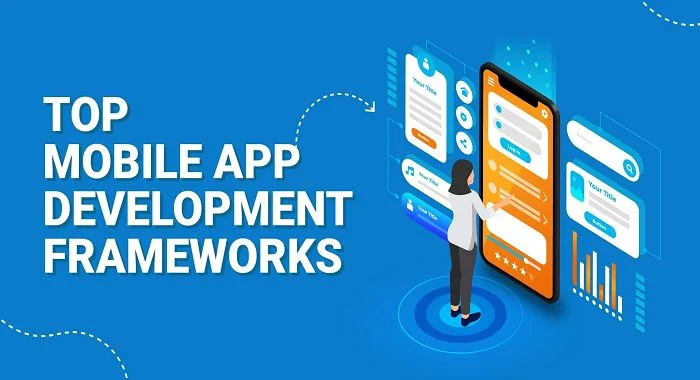Choosing the right app development framework has become one of the most important decisions for developers and businesses alike. In 2025, mobile applications are the backbone of digital life. From social networking and online shopping to banking, healthcare, and even education, apps dominate how we interact with technology. But behind every successful app is a robust framework that makes development faster, smoother, and more efficient.
With hundreds of tools available, the question remains: which frameworks are the best for app development right now? Let’s dive into the most popular and powerful app development frameworks in 2025, their key features, and why they matter.

What is App Development Framework?
App development frameworks are software tools that simplify app creation by providing pre-built components, libraries, and tools to streamline the development process for both mobile and web applications. Popular cross-platform mobile frameworks include Flutter, React Native, and Xamarin, while Ionic and Sencha are common for hybrid and web app development. Choosing the right framework depends on factors like target platform, performance needs, and available developer expertise.
1. Flutter (Google)
Flutter, developed by Google, has quickly become one of the most popular frameworks for cross-platform app development. Using the Dart programming language, Flutter allows developers to create apps for Android, iOS, web, and even desktop—all from a single codebase.
Why Developers Love Flutter:
- Hot Reload: Makes experimenting and debugging much faster.
- Beautiful UI: Comes with customizable widgets for building sleek, native-like designs.
- Performance: Compiles to native ARM code, resulting in smooth performance.
- Community Support: Google’s backing ensures constant updates and improvements.
Flutter is perfect for startups and companies who want to launch apps across multiple platforms without maintaining separate codebases.
2. React Native (Meta)
React Native, backed by Meta (formerly Facebook), remains one of the strongest competitors in mobile development. Built on JavaScript and React, it allows developers to build mobile apps with a native look and feel.
Strengths of React Native:
- Reusable Code: Write once, deploy everywhere.
- Rich Ecosystem: Massive library of third-party plugins.
- Native Modules: Offers the ability to integrate with native code when high performance is needed.
- Large Community: Developers worldwide contribute tools, documentation, and libraries.
Many big names like Instagram, Tesla, and Airbnb use React Native. It’s a go-to choice if you want cross-platform efficiency while retaining near-native performance.
3. Swift (Apple)
For iOS-specific development, Swift is the undisputed king. Launched by Apple, Swift replaced Objective-C and quickly became the default language for iPhone, iPad, and Apple Watch applications.
Why Swift is Essential for iOS Developers:
- Speed and Safety: Known for performance and fewer runtime crashes.
- Modern Syntax: Easy to learn, especially for new developers.
- Seamless Integration: Works perfectly with Apple’s ecosystem (ARKit, CoreML, etc.).
- Long-Term Support: Apple continues to invest heavily in Swift’s growth.
If your target audience is Apple users, Swift offers the best path to building secure, high-performance apps.
4. Kotlin (Google Preferred)
Kotlin has become the official and most recommended language for Android app development. Supported by Google, it’s modern, concise, and interoperable with Java.
Why Kotlin Dominates Android Apps:
- Concise Code: Reduces boilerplate code compared to Java.
- Interoperability: Works seamlessly with existing Java libraries.
- Null Safety: Helps prevent the dreaded “null pointer exceptions.”
- Coroutines: Simplifies asynchronous programming for smoother app performance.
Kotlin is ideal for developers who want powerful Android apps while leveraging modern language features.
5. Xamarin (Microsoft)
Xamarin, part of the Microsoft ecosystem, is another strong cross-platform app development framework. It uses C# and the .NET platform to create apps for Android, iOS, and Windows.
Why Xamarin Stands Out:
- Shared Codebase: Up to 90% of code can be reused across platforms.
- Integration with Microsoft Tools: Works well with Visual Studio, Azure, and GitHub.
- Native Performance: Offers native APIs for better performance.
Xamarin is a great choice for enterprise-level projects and developers already working with Microsoft technologies.
6. Ionic
Ionic is a popular open-source framework for building hybrid mobile apps using HTML, CSS, and JavaScript. It’s well-suited for developers with a web background who want to step into mobile app development.
Why Developers Choose Ionic:
- Cross-Platform: One codebase for Android, iOS, and web.
- UI Components: Comes with pre-built UI elements that speed up development.
- Cost-Efficient: Great for small teams or businesses on a budget.
Although performance may not always match native apps, Ionic is an excellent option for MVPs (Minimum Viable Products) and simple applications.
7. NativeScript
NativeScript allows developers to use JavaScript, TypeScript, or Angular to build native apps for Android and iOS.
Key Advantages:
- Native API Access: Developers can use native APIs directly, without needing wrappers.
- Strong Integration with Angular and Vue: Great for developers already familiar with these frameworks.
- Open-Source Community: Actively maintained by contributors worldwide.
NativeScript is ideal for developers who want the flexibility of JavaScript frameworks while still producing fully native apps.
Which App Development Framework Should You Choose?
There’s no single “best” app development framework it depends on your project needs:
- For startups and cross-platform apps: Flutter or React Native.
- For iOS-only apps: Swift.
- For Android apps: Kotlin.
- For enterprise and Microsoft environments: Xamarin.
- For web developers moving into mobile apps: Ionic or NativeScript.
Conclusion
In 2025, app development frameworks are more powerful than ever, offering flexibility, scalability, and speed. The key is choosing the one that fits your project goals, team expertise, and target audience.
Whether you prefer the cross-platform strength of Flutter and React Native, the native excellence of Swift and Kotlin, or the enterprise integration of Xamarin, the future of app development looks brighter than ever. With these frameworks, developers can create innovative apps that not only meet user expectations but also set new standards in performance and design.
Also Check Why Ethical Hacking is More Important Than Ever in 2025




1 thought on “Best App Development Frameworks – Free Guide – 2025”